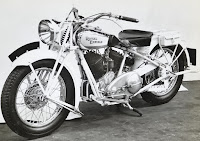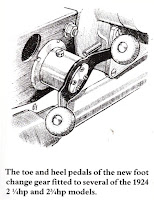Author and historian Anne Bradford brought the workers who created Royal Enfield in Britain to life in her 1996 book, "Royal Enfield, The Story of the Company and the People Who Made It Great, 1851-1969." Unfortunately, not all of the material she gathered would fit in the book. Fortunately, she left full copies of her interviews with the Redditch Library and the Royal Enfield Owners Club.
I've mined those outtakes to add to the story. You'll find the resulting blog items at these links:
Anne Bradford's magnificent outtakes
More from Anne Bradford's archive
More of "The People Who Made It Great"
The Royal Enfield four-valve motorcycles of the 1930s set an upscale pace. The trouble was making them reliable while constantly improving the cylinder-head design, and at the same time somehow keeping them affordable through those Depression years. The result was both creative and iconic, but the approach of wartime needs ended an era.
A Royal Enfield Flying Flea with bicycle pedals? There's no doubt Royal Enfield considered making RE2 two-strokes specially for Bermuda, which, for a time, required them. There's a photo of the prototype. But I couldn't find anyone in Bermuda who recalled seeing any such thing. And then it all fell into place. Now all we have to do is find one.
A Royal Enfield for a dictator? In 1933 Royal Enfield made a beautiful, specially prepared V-twin for the leader of a Latin America nation. The recipient wasn't revealed at the time, but I now think I know his name. If I'm right, the lucky leader was a ruthless dictator (and motorcycle enthusiast). Oddly, he was also an outspoken foe of Britain. Was the unique Royal Enfield a Foreign Office attempt to placate a troublesome opponent? Here's the story.
A Royal Enfield military motorcycle abandoned in France after Dunkirk is found, rescued and restored. Incredibly, it is the very same Royal Enfield WD/C shown in a self-portrait made by a wartime photographer as the enemy approached. Both cameraman and motorcycle would survive to lead interesting lives.
The Flying Flea Goes to War
...But What Did It Do There?
The Flying Fleas That Floated to War
Historical photos take us back to Sam Avellino's motorcycle shop in Revere, Mass. It was the legendary New England headquarters of Royal Enfield in the 1960s and '70s. The unforgettable Sam and his son Sam Junior would introduce Americans to Royal Enfields, including the mighty Interceptor.
The man on the motorcycle is the heroic Dutchman who created the Royal Enfield that became the Flying Flea. Meant as a poke in the eye to Nazis, Joop van Heusden's 125cc Royal Enfield "Royal Baby," designed for civilians, would join the war effort with British Airborne troops.
Royal Enfield's farewell to Johnny Brittain, the trials rider who won an unparalleled 13 ISDT gold medals: "He will be missed by all of us at RoyalEnfield," the company tweeted when he died, in 2019. But it was a touching scene at the Ace Cafe in 2013 (left) that I will always remember.
When Redditch and Royal Enfield were targets of the Luftwaffe. In 1940, Redditch, England, home of Royal Enfield, prepared for invasion. Historians have this map locating the sandbagged defenses, searchlights, anti-aircraft guns and flame bombs that would have met the enemy. It's a chilling reminder of World War II. Take a stroll back in time.
The stern looking police officer riding the Royal Enfield built Indian Chief in the well know catalog illustration is no actor. Thanks to readers I learned that the man on the motorcycle was Officer John Barkman of the Longmeadow, Mass. Police Department. He served the department from 1951-1974. Get the full story.
How the Flying Flea invaded America. The German DKW motorcycle was popular in Holland before World War II but the Dutch importer had Jewish board members. The German Nazis pulled the concession. The Dutch importer recruited Royal Enfield to build a copy of the DKW for them. The little 125cc two-stroke would win fame in the war as the Flying Flea, parachuted into battle with British airborne forces. The same Dutch importer brought the Flying Flea to the U.S. after the war. Here's the story.
Frank Buckles was the longest-lived U.S. veteran of World War I. He served in England and France as a motorcycle courier. Thanks to a newspaper reporter, a Royal Enfield owner with a long memory, and Royal Enfield USA, we now know for sure what kind of motorcycle Buckles rode: a Royal Enfield.
Kevin Mahoney, the hard working man behind Royal Enfield motorcycles in America, made his own luck. With the same energy and risk-taking it took to create Royal Enfield USA he might have gotten richer in some other line. Yet he says he wouldn't change a thing.
Historical photos take us back to Sam Avellino's motorcycle shop in Revere, Mass. It was the legendary New England headquarters of Royal Enfield in the 1960s and '70s. The unforgettable Sam and his son Sam Junior would introduce Americans to Royal Enfields, including the mighty Interceptor.
The stern looking police officer riding the Royal Enfield built Indian Chief in the well know catalog illustration is no actor. Thanks to readers I learned that the man on the motorcycle was Officer John Barkman of the Longmeadow, Mass. Police Department. He served the department from 1951-1974. Get the full story.
Frank Buckles was the longest-lived U.S. veteran of World War I. He served in England and France as a motorcycle courier. Thanks to a newspaper reporter, a Royal Enfield owner with a long memory, and Royal Enfield USA, we now know for sure what kind of motorcycle Buckles rode: a Royal Enfield.
Part I
Part II
Martin Scott is the man who brought made-in-India Royal Enfields to the United States in 1995. It was a case of one man and his family against government bureaucracy and Royal Enfield's own inexperience. Scott credits others with helping but there's no doubt, this is the man who did it. Read it .
The Royal Enfield Bullet Sixty-5 updated the made-in-India Royal Enfield from a motorcycle out of the 1950s to something more typical of the 1960s. It had special features, but was it truly a limited edition? Read about it.
Confusion over Royal Enfield models is nothing new. Royal Enfield has built a bewildering variety of motorcycles in its long history. For instance, did you know there was a Royal Enfield Bullet with a Unit Constructed Engine in 1963?
Royal Enfield workers in a secret, underground factory played an unwitting role in a Cold War experiment with germ warfare.
In a walking tour of Redditch, England, blogger Jorge Pullin talks about what's left to see of the old Royal Enfield factories and shows us what they look like today compared to when they made motorcycles.
Royal Enfield models:
Part II
Martin Scott is the man who brought made-in-India Royal Enfields to the United States in 1995. It was a case of one man and his family against government bureaucracy and Royal Enfield's own inexperience. Scott credits others with helping but there's no doubt, this is the man who did it. Read it .
The Royal Enfield Bullet Sixty-5 updated the made-in-India Royal Enfield from a motorcycle out of the 1950s to something more typical of the 1960s. It had special features, but was it truly a limited edition? Read about it.
Confusion over Royal Enfield models is nothing new. Royal Enfield has built a bewildering variety of motorcycles in its long history. For instance, did you know there was a Royal Enfield Bullet with a Unit Constructed Engine in 1963?
Royal Enfield models:













































